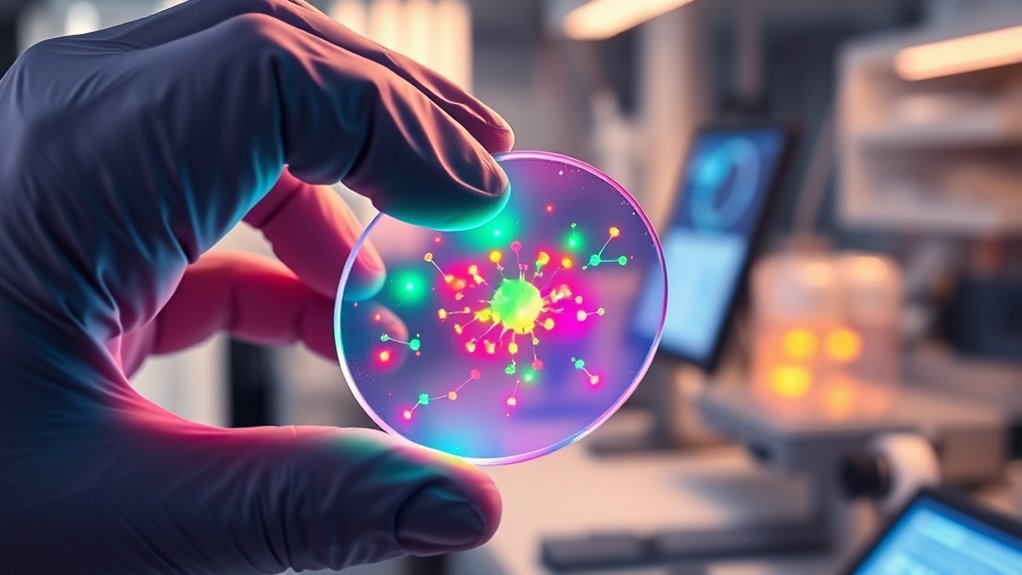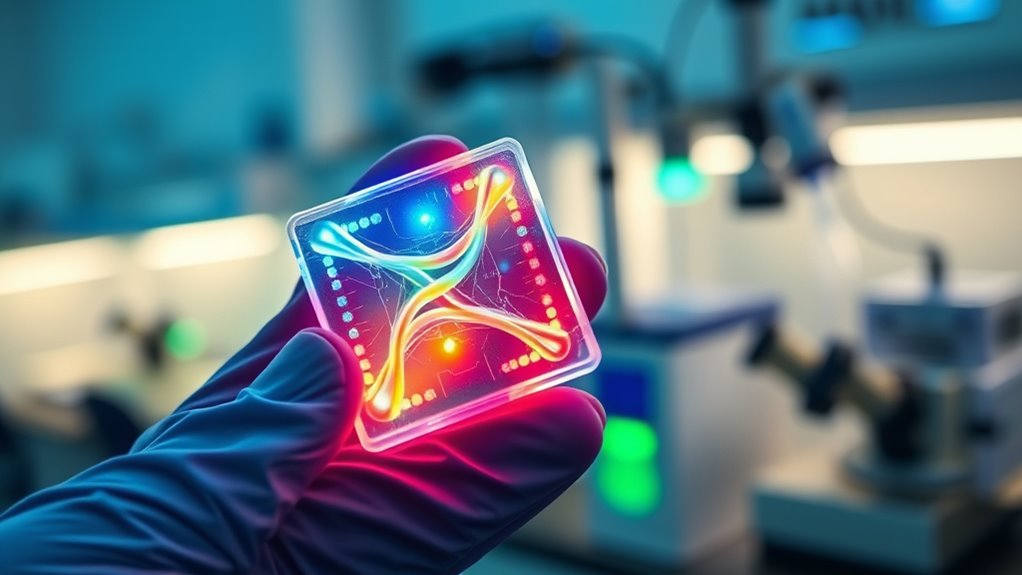Chemistry detects cancer by using specialized assays that identify biomarkers—molecules like proteins, DNA, or methylation patterns linked to tumors. Techniques such as ELISA, PCR, and advanced biosensors analyze blood, saliva, or tissue samples to spot these markers with high sensitivity and specificity. Multiplex tests measure multiple biomarkers at once, enhancing early detection. If you explore further, you’ll discover how these methods revolutionize cancer diagnosis and personalized treatment options.
Key Takeaways
- Biomarker assays detect cancer signals by measuring specific proteins, DNA, or methylation patterns indicative of tumor presence.
- Techniques like ELISA and PCR identify tumor-related molecules with high sensitivity and specificity.
- Multiplex assays analyze multiple biomarkers simultaneously, enhancing early detection accuracy.
- Electrochemical biosensors convert molecular interactions into electrical signals for rapid, portable cancer diagnostics.
- DNA methylation analysis detects cancer-specific epigenetic changes non-invasively through liquid biopsies.
What Are Cancer Biomarkers and Why Are They Important?

Cancer biomarkers are biological molecules found in blood, body fluids, or tissues that signal either normal or abnormal processes related to cancer. These markers include proteins, nucleic acids like microRNA, antibodies, peptides, and molecular signatures such as gene expression or metabolomics. They may be substances secreted by tumors or responses from the body to cancer presence. These biomarkers are crucial because they help detect cancer early, often through non-invasive tests, making screening easier and more accessible. The development of biomarker assays has advanced significantly, enabling more accurate and reliable detection methods. They also aid in differentiating cancerous from non-cancerous conditions. By providing information about the disease, biomarkers support diagnosis, prognosis, and personalized treatment plans. Their ability to indicate cancer presence and behavior makes them essential tools in improving patient outcomes and guiding effective therapies. Additionally, ongoing research continues to uncover new biomarkers, expanding the potential for early detection and targeted therapies. Innovations in molecular detection methods are further enhancing the sensitivity and specificity of these assays, opening new avenues for cancer management.
Techniques Used to Detect Cancer Biomarkers

Detecting biomarkers associated with cancer relies on a variety of laboratory techniques that identify and measure specific molecules indicative of the disease. ELISA allows you to detect proteins by measuring labeled antigens, offering high specificity.
PCR amplifies DNA sequences, making it easier to identify genetic biomarkers even at low levels.
Western blotting confirms the presence of specific proteins in a sample.
Immunohistochemistry (IHC) evaluates tissue samples, helping you assess markers like HER2.
Flow cytometry analyzes cell suspensions, enabling precise quantification of biomarkers on cell surfaces.
Advanced methods like biosensors, Next-Generation Sequencing, and multiplex assays provide higher sensitivity, multiplexing, and all-encompassing insights.
These techniques form the foundation for accurate cancer detection and diagnosis, tailored to various sample types and clinical needs.
The Power of Multiplex Assays in Cancer Diagnosis

Multiplex assays have revolutionized cancer diagnosis by enabling the simultaneous measurement of multiple biomarkers within a single sample. Using platforms like Luminex xMAP, you can analyze proteins, DNA methylation patterns, cytokines, and growth factors from serum, plasma, tissues, or cells. This extensive detection capacity supports research across various cancer types, including lung and breast cancer. Multiplexing speeds up studies, providing thorough insights into tumor biology and early detection. These assays offer high sensitivity and specificity—some achieving over 90%—for identifying early-stage cancers and predicting multiple cancer types at once. They also facilitate non-invasive testing by analyzing circulating biomarkers, often outperforming traditional methods. Additionally, understanding the emotional support needed by patients undergoing cancer testing can improve overall care and patient outcomes.
How Electrochemical Biosensors Identify Tumor Markers

Electrochemical biosensors leverage their ability to convert molecular recognition events into measurable electrical signals, making them powerful tools for identifying tumor markers. They use electrode interfaces functionalized with bio-recognition elements like antibodies, aptamers, or DNA probes to specifically detect targets such as tumor proteins, nucleic acids, or extracellular vesicles. When the target binds, it triggers a change in the electrical signal—often amplified by nanocomposites or redox labels—allowing for sensitive detection. These sensors require minimal sample volumes and respond rapidly, making them ideal for early diagnosis and real-time monitoring. Their high sensitivity and selectivity enable detection of low-abundance markers in complex fluids like blood, offering cost-effective, portable solutions for point-of-care cancer diagnostics, especially in resource-limited settings. Essential oils for specific health issues can also be utilized to support patient comfort and overall well-being during diagnostic procedures. Additionally, advances in biosensor technology are continually improving detection capabilities and expanding clinical applications. The integration of cybersecurity measures is essential to protect patient data and ensure the integrity of diagnostic results during digital data transmission.
The Role of DNA Methylation in Cancer Detection

DNA methylation plays an essential role in cancer detection by serving as a stable and accessible biomarker that reflects changes in gene regulation associated with tumor development. It involves adding methyl groups to DNA, often at CpG sites, which can silence tumor suppressor genes or activate oncogenes.
Because these methylation marks are stable, they make reliable indicators for detecting cancer. You can analyze methylation patterns from biological fluids like blood, urine, or saliva, making testing non-invasive.
Techniques such as liquid biopsies allow early detection by identifying cancer-specific methylation changes in circulating cell-free DNA. These biomarkers not only help detect cancer early but also distinguish tumor types and monitor disease progression, providing valuable insights for personalized treatment strategies.
Clinical Impact of Biomarker Testing in Cancer Management

Biomarker testing has transformed cancer management by substantially improving diagnostic accuracy and patient stratification. You can now detect molecules like DNA, RNA, proteins, and metabolites that tumors produce or respond to, enabling more precise diagnosis and subclassification. Additionally, innovative techniques utilize diverse designs of testing platforms to enhance sensitivity and specificity. Testing identifies genetic alterations such as EGFR, ALK, and ROS1, guiding targeted therapies. Using tissue samples or blood-based liquid biopsies allows for less invasive, all-encompassing tumor profiling. Biomarkers differentiate cancer types and subtypes, improving diagnostic precision beyond traditional methods. They also enable early detection of drug resistance, allowing timely treatment adjustments.
Frequently Asked Questions
How Do Biomarker Assays Distinguish Between Benign and Malignant Tumors?
You might wonder how biomarker assays tell benign from malignant tumors. These tests analyze samples to identify specific genetic mutations, proteins, or substances linked to cancer.
Malignant tumors often exhibit unique biomarkers indicating genetic instability or aggressive behavior. By detecting these differences, biomarker assays help you distinguish between benign growths and malignant cancers, guiding diagnosis and informing appropriate treatment strategies effectively.
What Are the Limitations of Current Cancer Biomarker Detection Techniques?
Sure, because who doesn’t love a perfect, foolproof cancer test? Sadly, current techniques face big hurdles. You might get false positives or negatives, leading to misdiagnosis or missed cancers.
Tests are expensive, not always accessible, and lack specificity—meaning non-cancer tissues can cause confusion. Plus, technology is evolving slowly, and many assays are used only after diagnosis, not for early detection, limiting their true potential.
Can Biomarker Testing Predict Patient Response to Specific Therapies?
You want to know if biomarker testing can predict how you’ll respond to specific therapies. It can, because it identifies molecular features of your tumor, like gene mutations or protein levels, that indicate likely treatment success.
How Affordable and Accessible Are These Biomarker Assays Worldwide?
Imagine it’s the 21st century, and you’re wondering how affordable and accessible biomarker tests are worldwide. You’ll find that costs vary greatly; innovations like Singapore’s Heatrich-BS assay offer tests for about US$35, making them more accessible.
In wealthier countries, these tests are widespread, but in lower-income regions, access remains limited due to infrastructure and funding gaps. International partnerships and new technologies are helping bridge this divide, making testing more affordable and available globally.
What Advancements Are Expected in Non-Invasive Cancer Detection Methods?
You’re curious about upcoming advancements in non-invasive cancer detection. Expect improvements in liquid biopsy sensitivity, making blood tests more accurate across all cancer stages.
Optical imaging techniques will become faster and more precise, enabling real-time diagnostics.
Additionally, non-invasive methods like saliva, urine, and breath analysis will become more reliable and widespread.
AI integration will enhance data interpretation, leading to earlier detection, personalized treatments, and better patient outcomes, transforming cancer care profoundly.
Conclusion
Understanding how chemistry detects cancer through biomarker assays can save lives. Did you know that over 70% of cancer diagnoses now rely on biomarker testing? By utilizing techniques like multiplex assays and electrochemical biosensors, you can catch cancer earlier and tailor treatments effectively. Staying informed about these advances empowers you to recognize the importance of early detection, ultimately improving outcomes and survival rates.









